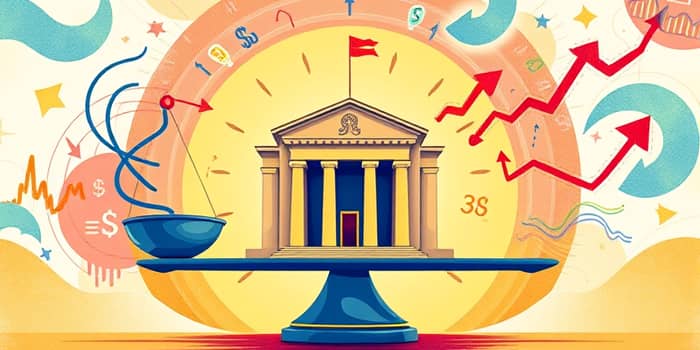As financial markets brace for the Federal Reserve’s next decision, stakeholders around the globe weigh the implications of steady policy. This detailed analysis explores the data, debates, and deeper strategy behind the Fed’s stance, empowering readers with context and actionable insight.
Current Policy Landscape
At its five most recent meetings, the Federal Open Market Committee (FOMC) has held the Federal Funds Rate at 4.25%–4.50%. This represents a modestly restrictive stance in light of a neutral rate estimated around 3%. Officials have signaled patience, emphasizing the need to assess incoming data.
Despite growing calls for easing, most participants agree that waiting serves both the inflation and employment mandates. The Fed’s balance sheet reduction continues, as holdings of Treasury and mortgage-backed securities decline steadily, reinforcing the tightening effect beyond the headline rate.
Economic Underpinnings
Recent growth figures reveal real GDP expansion of 1.4% annualized in H1 2025, below estimates of long-run potential. This sub-potential pace underscores lingering output gaps and raises questions about the resilience of consumer demand.
Meanwhile, core inflation sits at roughly 3%, about one percentage point above the Fed’s 2% longer-run goal. Tariff policies implemented in mid-2025 have introduced added price pressures, particularly in durable goods and intermediate inputs.
On the labor front, the unemployment rate has edged higher from extraordinarily low levels and July job gains were weaker than expected. While payroll growth remains positive, downward revisions to prior months have fueled concerns about a softening labor market.
FOMC Dynamics and Dissent
The September 2025 decision marked the first time this cycle that two members—Governors Bowman and Waller—dissented in favor of a 25 basis-point easing move. They highlighted labor market weakening as justification for preemptive support.
- Majority view: Maintain rates until clear inflation progress.
- Dissenting view: Early cut to support employment.
- Balance sheet runoff: Continues unless policy shifts.
This split illustrates the tension between guarding against inflation persistence and addressing emerging labor risks.
Inflation Pressures and Tariffs
New tariff measures have been a central factor in unexpectedly elevated price readings. Economists debate the magnitude of pass-through effects, with some Federal Reserve officials warning that higher import costs could prolong above-target inflation.
At the same time, core service inflation remains sticky, driven by housing and health care costs. The Fed’s challenge is to disentangle transitory tariff shocks from underlying demand-driven price pressures—a task that shapes both policy calibration and communications strategy.
Policy Framework and Transparency
In August 2025, the Fed unveiled its updated “Statement on Longer-Run Goals and Monetary Policy Strategy,” reaffirming its commitment to the dual mandate of maximum employment and stable prices over the long term. The 2% inflation target remains central, but transparency and accountability received fresh emphasis.
Through its “Fed Listens” initiative, the Fed held ten events and a major research conference, gathering direct community feedback. This outreach informs the analytical approach, ensuring that policy decisions reflect a range of real-world impacts and academic insights.
Market Speculation and Forward Guidance
Investor expectations strongly signal rate cuts ahead. Pricing suggests a 75%–85% probability of a 25 basis-point reduction at the September FOMC meeting. Treasury yields have fallen, equity markets rallied, and the dollar softened in response to even subtle Fed communications.
- Market-implied cut odds: 75%–85% for September.
- Yield shifts: Short-term yields down, curve flattening.
- Currency moves: Dollar weakness boosts exports.
Despite these signals, policymakers stress a data-dependent approach. Should inflation remain stubborn or new shocks emerge, easing may be delayed or scaled back.
Looking Ahead: Jackson Hole and Beyond
The upcoming Jackson Hole symposium will be a pivotal event. Chair Powell’s remarks could recalibrate expectations, offering insights into how the Fed interprets recent data and balances competing risks.
Ultimately, the Fed’s next move will reflect a balanced approach to evolving risks. By integrating public feedback, emphasizing transparency, and adhering to its dual mandate, the Fed aims to navigate the complex interplay of growth, inflation, and market sentiment—charting a course toward long-term stability and prosperity.
References
- https://tradingeconomics.com/united-states/interest-rate
- https://www.federalreserve.gov/monetarypolicy/review-of-monetary-policy-strategy-tools-and-communications-2025.htm
- https://www.brookings.edu/articles/the-fed-does-listen-how-it-revised-the-monetary-policy-framework/
- https://www.federalreserve.gov/newsevents/pressreleases/monetary20250822a.htm
- https://www.federalreserve.gov/monetarypolicy/fomcminutes20250730.htm
- https://www.federalreserve.gov/monetarypolicy/monetary-policy-strategy-tools-and-communications-statement-on-longer-run-goals-monetary-policy-strategy-2025.htm
- https://www.federalreserve.gov/monetarypolicy/fomccalendars.htm
- https://www.stlouisfed.org/from-the-president/remarks/2025/economic-conditions-risks-monetary-policy-remarks-peterson-institute










